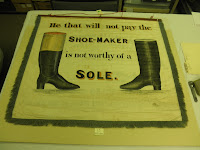 |
| Early 19th century, Grafton Public Library. |
 |
| Angel firehouse banner - image from ARTAID.org |
have) one purpose, if you want to say something, you put it on a banner and hang it up for the world to see. Banners have been used to make political statements, they tout success, they pay homage to heroes. Such is the case with Firehouse Banners. Several examples exist from the Victorian Period. A firehouse banner usually has the fire department name on it, and as you would expect, it was hung proudly in the firehouse. However, the firehouse banner cannot be pigeon-holed into the past, as evidenced by the "Angel" banner which now graces some of the FDNY firehouses whose firefighters were lost on September 11th, 2001.
 |
| Trade Banner, 1841. Maine Historical Society |
 |
| Inside of the banner, filled with 100 years of dirt, but look at the original teal color. |
The good people of Morrisville wanted to restore their banner and, if possible, rehang it in the firehouse. To do this the banner needed to be housed in a way that would protect it. Remember though, this is a double sided banner. If it is framed, one side will be lost. The solution? A two-sided display case.
The banner is to hang in the display case using the original brass rings, rod and finials. The stress points caused from the junction where the ring meets the fabric and is stitched to the banner was deemed too fragile to re-affix the rings. Another solution was needed.
 To construct, sometimes you must deconstruct. The banner has two sides, and those sides required separation from each other during internal cleaning and re-application of the badly disintegrating padded layer making up the center of the banner. SAC conservators Gwen Spicer and Nicolette Cook came up with the idea to integrate a piece of sheer fabric, which would run the length of the top of the banner. It would be secured using running stitches and approximately 2 inches of the sheer fabric would be extended from the top of the banner. The sheer fabric created a sleeve (much like the space where the rod passes through a curtain). The fabric would hang from the rod, and the banner then would hang from the fabric. The brass rings would then be affixed to this sheer fabric, thus eliminating the stress to the original fabric. The trick was to get the rings around the rod, and through the sheer fabric. In other words: the sheer fabric had to go around the rod, the rings had to go through the sheer fabric and around the rod, and then the banner had to be stitched to the fabric, therefore "sealing" in the sheer fabric, rings and rod.
To construct, sometimes you must deconstruct. The banner has two sides, and those sides required separation from each other during internal cleaning and re-application of the badly disintegrating padded layer making up the center of the banner. SAC conservators Gwen Spicer and Nicolette Cook came up with the idea to integrate a piece of sheer fabric, which would run the length of the top of the banner. It would be secured using running stitches and approximately 2 inches of the sheer fabric would be extended from the top of the banner. The sheer fabric created a sleeve (much like the space where the rod passes through a curtain). The fabric would hang from the rod, and the banner then would hang from the fabric. The brass rings would then be affixed to this sheer fabric, thus eliminating the stress to the original fabric. The trick was to get the rings around the rod, and through the sheer fabric. In other words: the sheer fabric had to go around the rod, the rings had to go through the sheer fabric and around the rod, and then the banner had to be stitched to the fabric, therefore "sealing" in the sheer fabric, rings and rod. |
| Banner after treatment - fabric covers the rod, the rings are "embedded" between the rod, fabric and banner. |
The sheer fabric was cut in a "comb" like pattern. The top of each comb, was seared with a soldering iron to create a perfectly round hole, which the ring would fit into. Additionally, the color of the sheer fabric was intentionally chosen to create a near match to the rod, allowing it to become virtually invisible once the brass rings surround it. The outcome is a banner that is conserved and displayed in a way that is beneficial to the banner and pleasing to the people who found this lost treasure in the hopes it would not only be displayed again, but for a long time to come.
 |
| Side 2, after treatment |
 |
| Side 1, after treatment |






